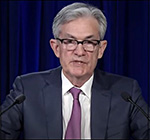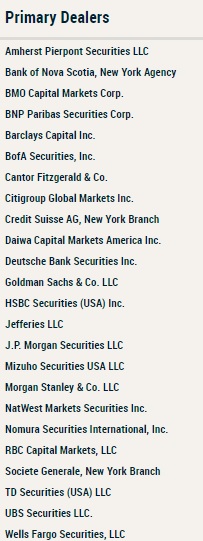By Pam Martens and Russ Martens: March 1, 2021 ~
Beginning on September 17, 2019 – months before there was any report of a COVID-19 case anywhere in the world – the Federal Reserve turned on its money spigot to the trading houses on Wall Street. By October 23, 2019 the Fed announced that it was upping these loans to $690 billion a week – again, months before any report of COVID-19 anywhere in the world. Earlier in October 2019, the Fed had also announced that it would be buying back $60 billion a month in Treasury bills.
Within a span of six months, the Fed had pumped out a cumulative $9 trillion in loans to Wall Street’s trading houses, according to its own spread sheets, with no peep as to which Wall Street firms were getting the bulk of that money. It’s more than a year later and the American people still have no idea what triggered that so-called “repo loan crisis” or which Wall Street firms were in trouble or remain in trouble.
The Federal Reserve, as is typical, outsourced this money spigot to the New York Fed, which is literally owned by some of the largest banks on Wall Street. We wrote at the time the New York Fed was making these massive repo loans that this action was unprecedented in Federal Reserve history for the following reasons:
No Wall Street crisis has been announced to the public to explain these massive loans and Treasury buybacks;
Not one hearing has been held by Congress on the matter;
Not one official elected by the American people has authorized these loans;
The loans are not being made to commercial banks (which could re-loan the money to stimulate the U.S. economy). The loans are going to the New York Fed’s primary dealers, which are stock and bond trading houses on Wall Street who count hedge funds among their largest borrowers; (See list below. There is only one bank among the 24 primary dealers.)
Many of the primary dealers are units of foreign banks whose share prices have been in freefall. The Fed is making these loans at approximately 2 percent interest – an interest rate these firms could not come anywhere close to obtaining in the open market;
These same foreign banks are counterparties to mega U.S. banks’ derivative trades – raising the suggestion that this is another bailout of Wall Street’s derivatives mess as occurred in 2008;
The Dodd-Frank financial reform legislation of 2010 was supposed to rein in this exact type of abuse by the New York Fed and, in fact, it states that Congress must be informed as to which banks are receiving the money to be sure it’s not going, once again, to failing financial institutions as happened in the last crisis;
The Government Accountability Office (GAO), when it released its audit of the Fed’s bailout programs of 2007 to 2010 chastised the Fed for failing to document the reasons it was flinging trillions of dollars to Wall Street and foreign banks. Notwithstanding the GAO’s report, the New York Fed is back to its old tricks again;
The New York Fed is owned by its members banks in its region. Representatives of these banks sit on its Board of Directors. It is thus too conflicted to be in charge of this bailout money spigot which is ultimately backstopped by the U.S. taxpayer if the New York Fed fails;
The New York Fed is the regulator of the largest bank holding companies in the U.S. But its failure as a regulator is why these same banks needed to be massively bailed out in 2008 and, apparently, again now. This system lacks any semblance of checks and balances;
The parent organizations of five of its primary dealers have admitted to criminal felony counts brought by the U.S. Department of Justice for frauds against the investing public. Bailing out felons and Wall Street firms with serial histories of wrongdoing perpetuates moral hazard and, thus, more wrongdoing and bailouts.
The House Financial Services Committee has announced that it will hold a hearing on March 23 titled: “Oversight of the Treasury Department’s and Federal Reserve’s Pandemic Response.”
This is part of the ongoing series of hearings where both the U.S. Treasury Secretary and Federal Reserve Chairman show up to pretend that the American people are receiving complete transparency on what the Fed is doing with its money creation powers. (It’s another one of those Big Lies that have come to dominate this era of American history.) While former Treasury Secretary Steve Mnuchin and Fed Chair Jerome Powell starred in this dog and pony show last year, the March 23 hearing will hear from the new Treasury Secretary and former Fed Chair, Janet Yellen, along with Powell.
There is little hope of seeing any new sunshine from this pair, since Yellen hasn’t even disclosed the millions of dollars she received in speaking fees from Wall Street banks and trading houses in 2018, the year she stepped down as Fed Chair. As for Powell, hope for transparency was extinguished when we reported in August of last year that the Wall Street investment manager, BlackRock, was managing upwards of $25 million of Powell’s personal money while landing three no-bid contracts with the Fed to manage part of its emergency lending programs. One of those programs, the Secondary Market Corporate Credit Facility, allowed BlackRock to buy back its own sinking Exchange Traded Funds, some of which were invested in junk bonds.
The Fed has gone out of its way to foster the impression that its middle name is transparency. For example, on April 23 of last year it issued a press release which said:
“Building on its strong record of transparency and accountability around financial reporting and the policymaking process, the Federal Reserve Board on Thursday outlined the extensive and timely public information it will make available regarding its programs to support the flow of credit to households and businesses and thereby foster economic recovery. Specifically, the Board will report substantial amounts of information on a monthly basis for the liquidity and lending facilities using Coronavirus Aid, Relief, and Economic Security, or CARES, Act funding….”
Indeed, the Fed is reporting a substantial amount of information on a monthly basis on some of its Section 13(3) emergency lending facilities, but no one in Congress is demanding transparency on its previous $9 trillion in cumulative repo loans or on three of its ongoing emergency lending facilities that have yet to release one name of a loan recipient: the Primary Dealer Credit Facility (PDCF), the Commercial Paper Funding Facility (CPFF), and the Money Market Mutual Fund Liquidity Facility (MMLF).
The PDCF, CPFF, and MMLF were the first three Section 13(3) emergency lending facilities created by the Fed. All three programs were created in mid-March of 2020. Today is the first day of March 2021 and yet not one name of a loan recipient in those three programs has been released by the Fed.
According to the Fed’s H.4.1 report for Wednesday, April 1, 2020, just weeks after creating the PDCF and MMLF, they had, respectively, loaned out $33 billion and $52 billion to unnamed Wall Street firms.
The Commercial Paper Funding Facility first made an appearance on the Fed’s H.4.1 release on Wednesday, April 15, 2020. At that point, it had already made $974 million in loans to a Special Purpose Vehicle (SPV) that was created to buy up commercial paper that was, ostensibly, too toxic to roll over or find an alternative market for issuance. The end recipient of this Fed largesse has yet to be named.
The CPFF continued to grow exponentially each month after its creation, reaching $12.8 billion by June 17, 2020, according to the Fed’s H.4.1.
The Fed’s most recent H.4.1 for February 24, 2021 shows the following outstanding loans to these three emergency facilities that have never reported one name of the ultimate loan beneficiary: $265 million for the PDCF; $1.6 billion for the MMLF; and $8.6 billion for the CPFF.
Trust will continue to erode in both Wall Street and the Fed until Americans get a transparent accounting of where this money went and why it went there.



